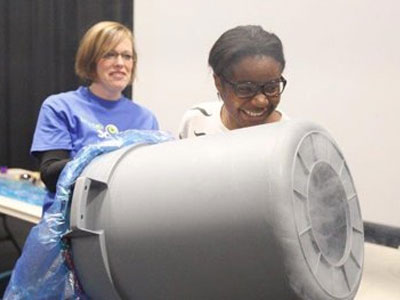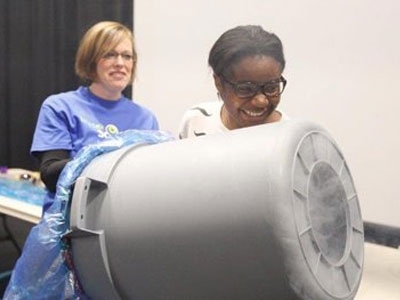How can I make a Vortex Cannon?


How does this align with my curriculum?
Build a vortex cannon and discover how fluids (liquids and gases) can move in unique ways due to their physical properties.
What You Need
- Large plastic garbage can with the hole cut in the bottom (see image)
- Sheet of plastic large enough to cover the large opening of the garbage can
(a plastic garbage bag will do) - A bungee-type cord long enough to TIGHTLY seal the plastic sheet over the
large opening of the garbage can - Smoke machine with smoke liquid - optional (easy to find in October)
- Plastic cups
Safety First!
Do not shoot at a person’s face. If using a smoke machine, be sure to follow any included safety instructions.
What To Do
Part 1: Air Cannon
- Stretch the plastic sheet over the large opening of the plastic garbage can. Wrap the bungee-type cord around the garbage can and plastic to hold it in place.
- Set up the plastic cups in a pyramid, on a table.
- Hold the garbage can so that the small opening is facing the cups.
- Tap on the plastic sheet, while aiming at the cups. The air coming out of the cannon should knock down the cups. You may need to move around to find the best distance away from the cups.
Part 2: Fog Cannon
- To make smoke rings, use the smoke machine to fill the garbage can with smoke, following directions on the smoke machine.
- Once the garbage can is full of smoke, tap on the plastic sheet. Once again, you’ll have to practice to see how hard you have to tap on the plastic sheet to make the best rings. Too hard, and the blast will be too fast to see, and too soft, the rings won’t form well.
Related Activity Video: Giant Smoke Rings – Cool Science Experiment (Video – 2:05min)
Discovery
The blast of air that shoots out of the cannon is called a flat vortex. A vortex is created when the air exiting the hole at the center is travelling faster than the air exiting around the edge of the hole. Bernoulli’s principle states, “the faster a flow of air is moving the lower its pressure.” Since the air inside the blast is moving faster than at the outside of the blast, the resulting inward pressure is the force that creates the inward vortex. This generated vortex holds the smoke in the “rings.” Eventually air friction removes the energy stored in the vortex and the smoke ring drifts to a stop. The suspended particles of dust (or smoke) make the gas vortex and the pattern of gas movement visible, as air cannon demonstrates.
Aside from being a fun trick, the air cannon demonstrates how fluids (liquids and gases) can move in unique ways due to their physical properties. A vortex is a circular pattern of particle motion that can occur in a variety of different turbulent gases and liquids. Vortex rings can be formed as a solid object moves or falls very fast through a fluid. Spinning helicopter propellers can sometimes create a dangerous vortex that makes steering and manoeuvring the helicopter difficult. Vortices can also occur as a gas is pushed through a liquid as observed in the bubble rings that dolphins or scuba divers make when they blow out air under water. There are even vortex rings that form in blood in the human heart as blood is pumped through the heart valves.
- Look at the motion of water: carefully put one drop of food colouring into a tall glass of water and observe closely. What do you notice?
For more information on this topic check out these Let's Talk Science resources:
- What is air turbulence? (STEM in Context) - Learn about the science behind the four main causes of turbulence.
- Why do curveballs curve? (STEM in Context) - Bernoulli’s equation is key to understanding why curveballs curve.
What’s happening?
The blast of air that shoots out of the cannon is called a flat vortex. A vortex is created when the air exiting the hole at the center is travelling faster than the air exiting around the edge of the hole. Bernoulli’s principle states, “the faster a flow of air is moving the lower its pressure.” Since the air inside the blast is moving faster than at the outside of the blast, the resulting inward pressure is the force that creates the inward vortex. This generated vortex holds the smoke in the “rings.” Eventually air friction removes the energy stored in the vortex and the smoke ring drifts to a stop. The suspended particles of dust (or smoke) make the gas vortex and the pattern of gas movement visible, as air cannon demonstrates.
Why does it matter?
Aside from being a fun trick, the air cannon demonstrates how fluids (liquids and gases) can move in unique ways due to their physical properties. A vortex is a circular pattern of particle motion that can occur in a variety of different turbulent gases and liquids. Vortex rings can be formed as a solid object moves or falls very fast through a fluid. Spinning helicopter propellers can sometimes create a dangerous vortex that makes steering and manoeuvring the helicopter difficult. Vortices can also occur as a gas is pushed through a liquid as observed in the bubble rings that dolphins or scuba divers make when they blow out air under water. There are even vortex rings that form in blood in the human heart as blood is pumped through the heart valves.
Investigate further
- Look at the motion of water: carefully put one drop of food colouring into a tall glass of water and observe closely. What do you notice?
For more information on this topic check out these Let's Talk Science resources:
- What is air turbulence? (STEM in Context) - Learn about the science behind the four main causes of turbulence.
- Why do curveballs curve? (STEM in Context) - Bernoulli’s equation is key to understanding why curveballs curve.
